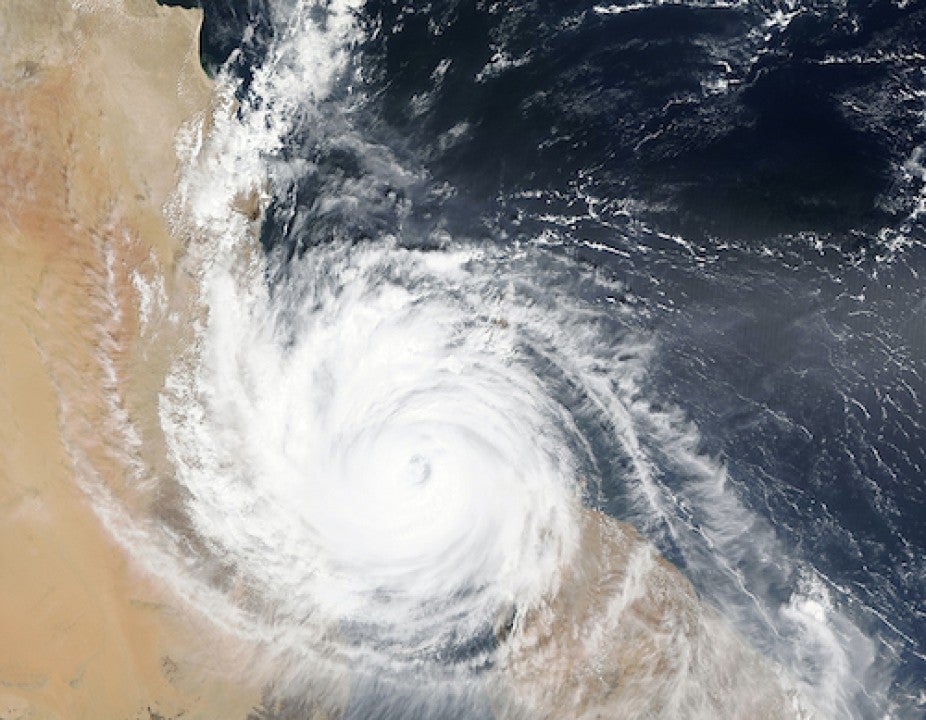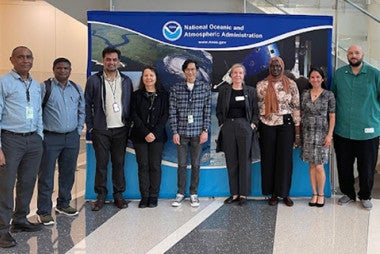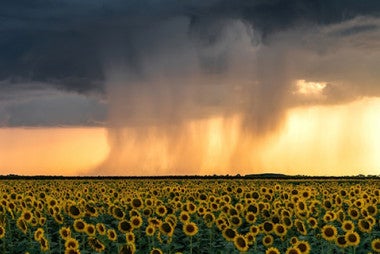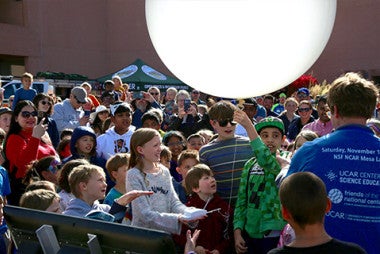Surge Protection from our National Hurricane Team
CPAESS has a crack team working at the National Hurricane Center’s Storm Surge Unit including: Laura Alaka, Associate Scientist; Joshua Alland, Associate Scientist; Lixion Avila, Casual Storm Surge Specialist; William Booth, Associate Scientist; Luis Cortes-Hernandez, Program Specialist; Ethan Gibney, Associate Scientist; and Tarah Sharon, Associate Scientist. This team takes life saving through prediction very seriously and doesn’t hesitate to work around the clock to do so. They provide real-time surge forecasts which are critically important as “Roughly half of all U.S. deaths from tropical cyclones are due to the storm surge, the rise in water levels from the tropical cyclone's winds piling water toward the coast just before and during landfall (Weather.com).”

NASA photo of a hurricane making landfall.
NASA
“The Storm Surge Unit, part of the Technical Support Branch, is a small group of highly trained meteorologists and oceanographers specializing in predicting storm surge heights accompanying landfalling tropical cyclones using the Sea, Lake, and Overland Surges from Hurricanes (SLOSH) computer model. As an integral part of the National Hurricane Center, the Storm Surge Unit produces operational SLOSH model predictions of the storm surge threat for landfalling hurricanes as well as model storm surge simulations of hypothetical storms for federal, state, and local emergency managers used in evacuation planning and storm preparation. Additionally, the Storm Surge Unit performs post-storm analyses and storm surge model verification and continually conducts education and outreach to alert the public of the dangers of storm surge (NOAA).”
This team specifically keeps an eye on the United States Atlantic and Gulf coasts, Hawaii, Puerto Rico, the U.S. Virgin Islands, and the Bahamas. These areas are covered by their SLOSH predictive model. The “Sea, Lake and Overland Surges from Hurricanes (SLOSH) model is a computerized numerical model developed by the National Weather Service (NWS) to estimate storm surge heights resulting from historical, hypothetical, or predicted hurricanes by taking into account the atmospheric pressure, size, forward speed, and track data. These parameters are used to create a model of the wind field which drives the storm surge. The SLOSH model consists of a set of physics equations which are applied to a specific locale's shoreline, incorporating the unique bay and river configurations, water depths, bridges, roads, levees and other physical features (NOAA).”

Picture showing that even elevated houses are no match for storm surges. This North Carolina home was felled by 15 feet of storm surge from Hurricane Floyd.
FEMA | Dave Gatley
Recently, the Storm Surge Unit completed a major milestone of updating the SLOSH basin, and associated flood risk maps for South Carolina and Georgia. UCAR | CPAESS scientists William Booth and Tarah Sharon provided major contributions to this important effort. These updates are very important as NOAA is predicting an above-normal season. “ For the 2022 hurricane season, NOAA is forecasting a likely range of 14 to 21 named storms (winds of 39 mph or higher), of which 6 to 10 could become hurricanes (winds of 74 mph or higher), including 3 to 6 major hurricanes (category 3, 4 or 5; with winds of 111 mph or higher). NOAA provides these ranges with a 70% confidence (NOAA).”
So having updated maps of hurricane prone areas in SLOSH translates into better information for emergency management. As “much of the United States' densely populated Atlantic and Gulf Coast coastlines lie less than 10 feet above mean sea level (NOAA)” work to continually increase predictive accuracy has the ability to substantially save lives. So this team’s work, like the significant updates executed by Tarah Sharon and William Booth, make a profound contribution to the safety of people in coastal areas.









